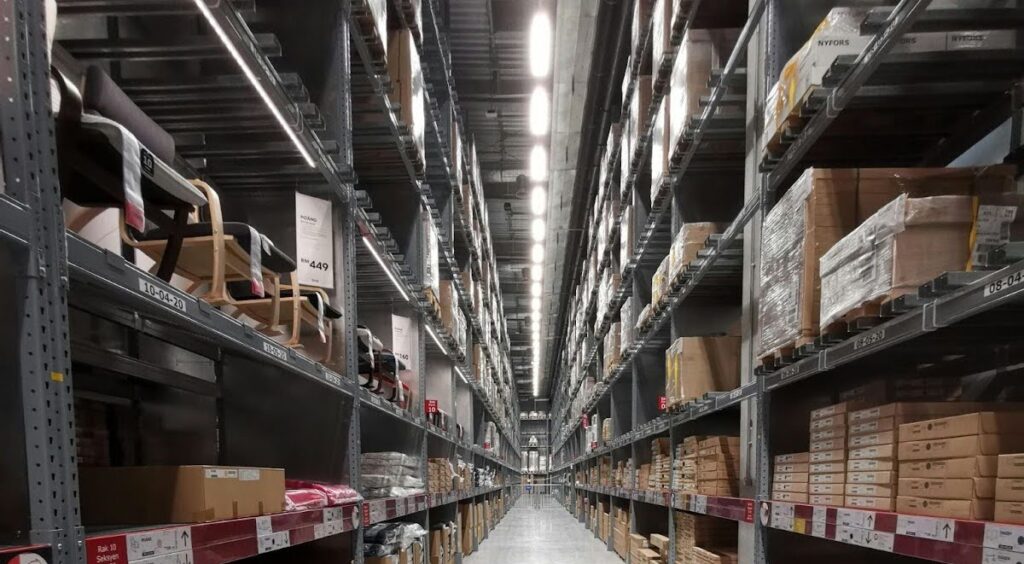8 Types of Warehousing Processes

Warehousing is a critical link in the supply chain. It facilitates the storage, handling, and distribution of goods. Effective warehouse management can optimize inventory control and meet customer demands efficiently.
Within this context, warehousing processes ensure smooth operations and maximize warehouse efficiency.
This article discusses various warehousing processes that contribute to efficient warehouse management. From receiving and storing goods to a picking process and shipping, we will explore key processes and provide valuable insights for effective warehouse management practices.
Join us as we unravel the intricacies of warehouse operations and offer tips for streamlining supply chain efficiency.
Definition of Warehousing Processes
Warehousing processes involve storage, handling, and dispatch processes within a warehouse facility. These processes are integral components of efficient warehouse management.
They ensure the flow of goods from receipt to distribution. Key warehouse processes include the receiving process, storing, picking, packing process, and shipping goods, as well as inventory management with complete quality control.
Regarding supply chain management, warehousing processes optimize inventory control and distribution efficiency. You can manage inventory levels and streamline processes with a warehouse management system.
It helps minimize stock outs, reduce carrying costs, and improve customer service. Moreover, efficient warehouse operation can contribute to the overall agility of the supply chain. It can enable businesses to meet dynamic market demands and respond promptly to customer orders.
Ultimately, warehousing processes serve as the backbone of supply chain operations. They act as strategic hubs for inventory management and distribution.
8 Key Warehousing Processes
Explore the eight important components of efficient warehouse management through this listicle:
1. Receiving and Inspection
The receiving and inspection process is the gateway to efficient warehouse management. It encompasses the meticulous acceptance of incoming shipments, verifying the accuracy of received goods against purchase orders, and inspecting them for damage or discrepancies.
By executing this critical step, warehouses ensure they receive the correct goods in optimal condition. This step is the foundation for accurate inventory management and seamless order fulfillment.
The managers must also identify and address any issues during the receiving and inspection stages. If they come across anything unusual, warehouses can mitigate potential disruptions to downstream processes and maintain high levels of customer satisfaction.
2. Inventory Management
Inventory management forms the backbone of efficient warehouse operations. It involves rigorous monitoring, tracking, and control of inventory levels. By implementing robust inventory management practices, warehouses can optimize stock levels, minimize stockouts, and ensure timely replenishment of goods.
This step enhances overall operational efficiency and also meets customer demands promptly. Effective inventory management practices enable warehouses to maintain accurate stock records, streamline order fulfillment processes, and respond swiftly to changing market demands.
Additionally, by leveraging advanced inventory management technologies and techniques, such as real-time tracking systems and demand forecasting algorithms, warehouses can enhance their agility and adaptability in dynamic market environments. Most warehouses rely on advanced warehouse management software to keep track of inventory.
3. Storage and Material Handling
Storage and material handling are integral components of warehouse management. They involve the movement of goods within the warehouse storage. Efficient storage layout design and complete incorporation of material handling equipment can maximize warehouse space utilization.
At the same time, it can reduce handling costs. Any warehouse can optimize workflow efficiency by strategically organizing storage areas and employing efficient material handling techniques. It can facilitate the smooth flow of goods through the facility without any confusion.
Proper storage and material handling practices also reduce the risk of inventory damage or loss. They ensure the integrity of stored goods and minimize operational disruptions.
4. Order Picking and Processing
Order picking and processing is an essential step in fulfilling customer orders accurately. Warehouses can minimize picking errors by implementing efficient picking strategies, such as batch or zone picking.
They can reduce order processing time and enhance order fulfillment accuracy with speed. Streamlining order-picking processes improves operational efficiency and also enhances customer satisfaction.
It ensures timely and accurate delivery of goods. Additionally, leveraging technology solutions such as automated picking systems or voice-picking technology can further optimize order-picking operations to increase productivity in the warehouse.
5. Packing and Shipping Process
Packing and shipping are critical stages in the warehouse process since they involve carefully preparing goods for transport. This includes securely packaging items and accurately labeling them for shipment.
By strategically executing packing and shipping procedures, warehouses can protect goods during transit and hand them over to customers in optimal condition. This enhances customer satisfaction and reduces the risk of returns or damage claims. Efficient packing and shipping preserve the warehouse’s reputation and foster long-term customer relationships.
6. Returns Processing
Returns processing involves the efficient handling and processing of returned goods from customers. By implementing streamlined returns management processes, warehouses can effectively manage the influx of returned items.
They can quickly reintegrate returns into inventory and minimize the impact of returns on overall warehouse operations. Timely and efficient returns processing helps warehouses maintain optimal inventory levels. Facilitating hassle-free returns and exchanges also enhances customer satisfaction.
7. Quality Control
Quality control measures help warehouses maintain the accuracy, reliability, and consistency of processes and outputs. This involves conducting regular inspections, audits, and quality checks to identify and address any deviations from established standards.
By upholding stringent quality control standards, warehouses can ensure product quality and customer satisfaction and mitigate the risk of errors or defects in inventory management and order fulfillment processes.
8. Warehouse Safety Management
Nobody should underestimate warehouse safety management. It helps create a safe work environment for warehouse personnel by implementing and enforcing safety protocols to prevent workplace accidents or injuries.
Providing comprehensive safety training, conducting regular safety inspections, and promoting a culture of safety awareness among staff can induce effective warehouse safety management.
By prioritizing warehouse safety, warehouses can safeguard the well-being of their employees and help them minimize the risk of costly accidents or unwanted events in the workplace.
Tips for Effective Warehouse Management Systems

Efficient warehouse management can streamline operations and meet customer demands effectively. Below are some practical tips and best practices to enhance warehouse management:
- Implement Technology: Incorporate warehouse management systems (WMS) and other technologies such as barcode scanners and RFID systems to automate processes. They help you track inventory accurately and improve overall efficiency.
- Process Optimization: Regularly review and refine warehouse processes to identify bottlenecks, eliminate inefficiencies, and streamline operations for enhanced productivity.
- Staff Training: Invest in ongoing training programs to empower warehouse staff with the necessary skills and knowledge. It can promote their safety and help them adapt to changing demands.
- Automation: Introduce automation solutions like conveyor systems, automated storage, AS/RS (retrieval systems), and robotics. They can increase efficiency, reduce labor costs, and minimize errors in warehouse operations.
- Optimize Layout and Organization: Arrange the warehouse layout strategically to minimize travel time, improve workflow efficiency, and optimize space utilization.
- Regular Inventory Audits: Conduct regular inventory audits to maintain accurate stock levels, identify discrepancies, and prevent stock outs or overstocking.
- Supplier Collaboration: Build strong relationships with suppliers to improve inventory visibility, ensure timely deliveries, and enhance supply chain reliability.
- Continuous Improvement: Encourage a culture of continuous improvement within the warehouse by soliciting feedback from staff. Implement suggestions for process enhancements and fostering innovation.
- Safety Protocols: Prioritize workplace safety by enforcing strict safety protocols. Provide proper training on equipment usage and conduct regular safety inspections.
The tips mentioned above offer a holistic approach to enhancing warehouse management.
The Future of Warehouse Operations
The future of warehousing is moving towards significant advancements. These advancements are driven by emerging technologies and evolving consumer demands. Key trends include:
- Artificial Intelligence (AI): AI-powered systems will revolutionize warehousing operations by enabling predictive analytics, dynamic inventory management, and autonomous decision-making.
- Robotics: Robotics will play an increasingly prominent role in warehouse automation, with robots handling tasks such as picking, packing, and sorting to enhance efficiency and reduce labor costs.
- Internet of Things (IoT): IoT-enabled devices will enable real-time monitoring of inventory, equipment, and environmental conditions. They can facilitate proactive maintenance and optimize resources.
- Cloud Computing: Cloud-based warehouse management systems will enable remote access, scalability, and data-driven insights for enhanced agility.
- Augmented Reality (AR): AR technology will enhance warehouse processes by providing workers with real-time information overlays. It can improve accuracy and efficiency in order picking and inventory management tasks.
These advancements can transform the warehousing landscape. They might allow businesses to adapt and meet customer expectations in a shorter time span.
Final Thoughts
Effective warehouse management relies heavily on understanding and efficiently implementing key warehousing processes. These processes are important for optimizing inventory control, streamlining operations, and ultimately meeting customer demands efficiently.
Businesses must remain agile in response to evolving market dynamics and emerging technologies. You may ask the industry experts for a little help at the initial stage of your business.
By embracing these principles and leveraging technological advancements, warehouses can increase their efficiency and responsiveness and survive in the ever-evolving landscape of supply chain management.
